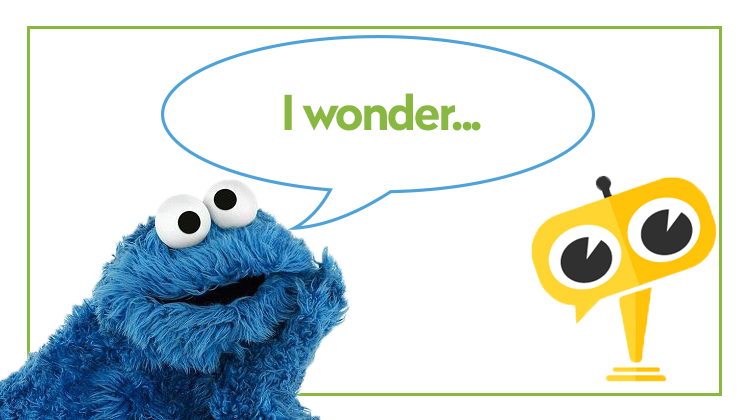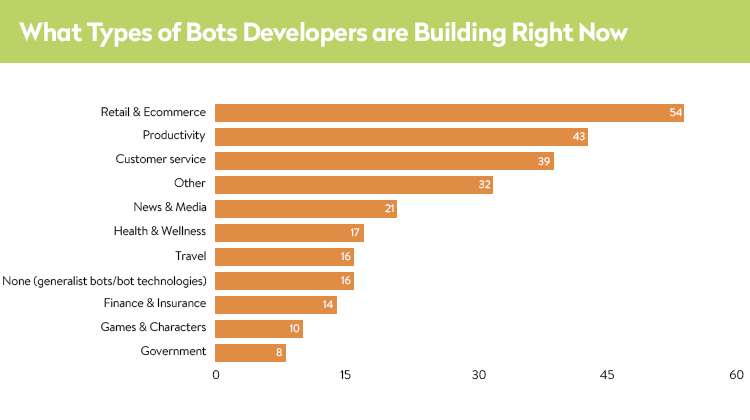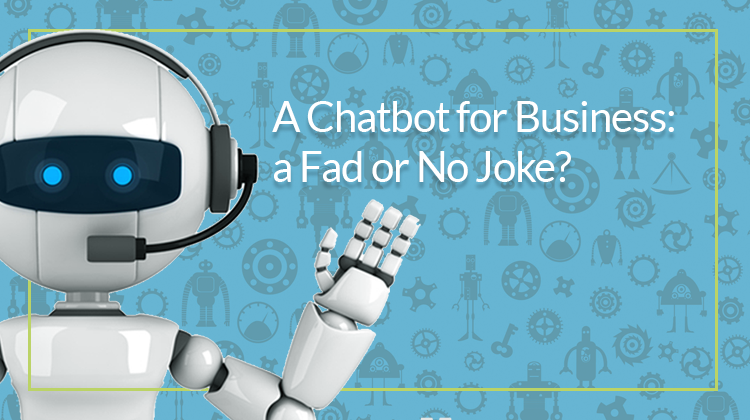Chatbots are all the rage. Messaging apps open up as platforms for ‘housing’ them. Human language is deemed ‘the new UI layer’, intelligent agents and digital assistants – the new browsers. And the conversational commerce trend is gaining ground.
The F8 conference stamped it: a chatbot for business is here to stay. It’ll cause a near-term disruption in how businesses interact with consumers and a long-term paradigm shift in how people will interact with machines. Giants like Microsoft, Facebook, Google, IBM, Amazon have strategies ready for the technology implementation and facilitation.
So, is it for real or just a conspiracy plan of the lucky few?
Why would anyone need a chatbot?

Benefits of chatbots for business
With all the hype, chatbots may come across as universal painkillers. But stemming from automation and intelligence, there’s clearly business-specific value. Here is how chatbots help businesses.
Data anxiety protection
Companies of all sizes face similar side effects of data abundance – infoxication, distraction, analysis paralysis. When it comes to data processing, what is known in military parlance as VUCA (volatility, uncertainty, complexity, ambiguity), ordinary people sum up like ‘It’s a crazy world!’ and stop trying. Infobesity protection is one of the top benefits of using a chatbot in business. Intelligent assistants deal effectively with informational queries and provide bite-sized personalized results.
Cost-efficient 24/7 responsiveness
Another one of the chatbot benefits for business is availability. The global economy extends communication immeasurably. Companies have to stay forever available to customers and partners from different time zones. Multi-channel interaction – social media mentions, email reach-outs, messaging, or calls – is overwhelming. But not with chatbots that listen, respond to, and distill the essence so that brands stay responsive and updated at all times. Sentiment analysis can help recognize customer mood and tackle issues early on.
Unique data aggregation & consumption
Businesses that use chatbots end up in possession of unique historical data about the interactions. Data aggregation, especially of unique and exclusive data, is inherently more valuable than the product (chatbot) itself. With intelligence tools available, this translates into a long-term strategy of building personalized communication, which not every company can afford otherwise.
Benefits of chatbots for customers
For them the beauty of bots lies in reducing friction to as close to zero as computing allows. Chatbots provide:
- Simplicity. No need to download yet another app, nor create an account or learn the intricacies of a user interface. Stay as natural and conversational as in everyday life.
- Efficiency. Get to the crux of the matter with the best response there is.
- Promptness. Instant and timely solutions to many problems.
- Convenience. Your smartphone is always at hand. And bots live within your messaging apps. You can summon them at will – by voice, text, or scanning QR codes.
So how serious is this ‘chatbot’ talk
Well, if you look at the present-day chatbot landscape, you’ll notice a well-developed infrastructure of tools, platforms, and businesses already making use of chatbots.

Image source: KeyReply
Let’s explain the picture. From the inside out, the concentric circles represent:
- Platforms. Most messaging platforms enable the existence of bots through robust send-and-receive APIs, frameworks, and ecosystems.
- Brands. Companies that have launched and experimented with bots.
- Providers. Companies that provide custom solutions to specific business areas.
- Tools. The supporting tools (e.g., natural language processing and dialogue architecture solutions, AI & ML capabilities) used by providers, brands, or developers to deliver bot experiences.
No matter how string-pulling the ‘chatbot’ talk may seem, gravitating towards chatbot development is justified. The recent BI Intelligence report concludes:
- AI has reached a stage in which chatbots can have increasingly engaging and human conversations, allowing businesses to leverage the inexpensive and wide-reaching technology to engage with more consumers.
- Chatbots are particularly well suited for mobile — perhaps more so than apps. Messaging is at the heart of the mobile experience, as the rapid adoption of chat apps demonstrates.
- The chatbot ecosystem is already robust, encompassing many different third-party chat bots, native bots, distribution channels, and enabling technology companies.
- Chatbots could be lucrative for messaging apps and the developers who build bots for these platforms, similar to how app stores have developed into moneymaking ecosystems.
So while skeptics are still unsure where this talk may take us, early adopters are busy reaping the benefits of the technology.
Do you need a chatbot for your business? Learn more: AI in Mobile Apps: How to Make an App like Siri.
Business ‘chatbotization’: do they even know why?
It’s hard to tell what percentage of companies has the motives for chatbot implementation other than ‘Everyone does it. So why shouldn’t we?’ But clearly our irrational self is ill-protected against numbers.

Just a quick look inside messengers, and you get it – chatbots overrun the apps. Take WeChat, for example, and you’ll see bots ready to:
- Hail a taxi
- Order food & drink delivery
- Buy movie tickets
- Customize and order a pair of Nikes
- Track your daily fitness progress
- Shop Burberry’s latest collection
- Book doctor appointments
- Host a business conference call
- Pay your water bill
…and the list goes on.
Facebook messenger hit 100,000 bots this year. And every single bot is the face of some brand. With 65 million businesses active on Facebook, this is just a start. To give you a taste of what’s coming, here’s an infographic:

Image source: Stefan Kojouharov
So why not try it out even if out of curiosity?
Top 10 industries using chatbots
According to botanalytics, these 10 ‘botified’ industries are doing best:
- Customer service & e-commerce
- Health
- Productivity
- News and publishing
- Beauty & fashion
- Media & entertainment
- Social tools
- Dining
- Travel
- Real estate
So who are those innovators, anyway? And what do they know better? Let’s take a glance.
Chatbot for customer service
Customer support is crucial for large businesses. So the giants like Starbucks, CNN, Microsoft, Tommy Hilfiger, KIA, Pizza Hut & Co are all employing a chatbot for customer service.
Chatbot for e-commerce
E-commerce giants are surprisingly fast to adapt, too. EBay’s ShopBot, for one, unveils the potential of a digital shopping assistant to cater to customer’s whims. If you are in e-commerce and want to build a chatbot for your business, check out what’s on the market.
Health
Healthcare is one of the industries where bots are expected to make a tremendous impact. Medical queries range from light to serious and urgent. In any case, leaving them unanswered builds up concern. Sharing them and getting advice has a therapeutic effect in itself. The Babylonhealth chatbot, Baxter, helps 1.2 million Londoners to avoid unnecessary doctor appointments and help patients with over-the-counter remedies. Using the system, patients chat with the bot about their symptoms, and the app determines whether they should see a doctor, go to a pharmacy, or stay home.
Productivity
Task automation is so congruent with the chatbot concept. And productivity bots are huge in working environment. Chatbottle counts 364 ‘productivity’-tagged bots. For teams using Slack as their enterprise messenger, there’s Slackbot to help teams communicate and operate efficiently. You can program Slackbot in a number of ways, and Slack even offers an API to create ‘Slack bots’ (not to be confused with Slackbot itself) to run within Slack. HuBot is another one developers like to play with.
News and publishing
Mass media companies are basking in the new environment, totally unaware of the advent of the MADCOM world (a future where machine-driven communications, enabled by artificial intelligence tools, will dominate the online information environment). They are happy to deliver subscription-based digests right to your IM app. Some reputable publishers, like CNN, are very satisfied with their bot experiments, resulting in greater scale and control with fewer man hours.
Beauty & fashion
You’d be surprised to see some well-known fashion brands explore the new territory, like H&M’s Kik-based intelligent assistant engaging in concierge services, Sephora’s Kik-based personal stylist, or Tommy Hilfiger’s Messenger bot helping people buy fashion directly from the runway during Fashion Week in NYC.
Entertainment
If you think entertainment doesn’t sound like serious business, you may be wrong. It is part and parcel of every brand strategy today. And chatbots can have their say here. The most popular bots today are ‘chatty’ ones. Want a weather forecast? Ask Poncho and get a delightful response. People just love it and come back for more.
Social tools
SMM and networking is all about engagement. And a fun, personalized conversation beats an ad or a video by a mile. Brands render their core values via the bots’ personalities. For instance, the TMY.GRL bot (courtesy of Tommy Hilfiger) walks the talk of its brand being a true fashionista. It allows people to access exclusive fashion content. Then there’s the Miss Piggy bot from Disney, which is fun, cheeky, and spirited. Adding a distinct flavor to these bots with a character is a core ingredient of success.
Dining
Food delivery industry was quick to realize the bot potential, too. A UK-based company Just Eat came to a tipping point when demand became too high for its existing staff to manage. So they devised a Messenger-dwelling advisor bot to help with the choice of the menu, place, and new food experiences. Tacobot, living on Slack, allows teams order from Taco Bell by voice or text.
Chatbot for travel
While comparing flights, accommodation, and itineraries for leisure is still more convenient on apps and sites, it often helps to have an assistant with urgent matters like booking, route changes and more. Concur is piloting a business travel Slackbot that could greatly speed up booking.
KLM bot from Royal Dutch Airlines doesn’t help you book your flight, but once you have your trip set up, it will help with updates, check-in notifications, and boarding documents, all through Facebook Messenger.
Cheapflights, Kayak, Expedia, and others have launched bots of their own to give recommendations on travel products, help customers book flights or hotels, and send booking confirmations on Messenger.
Chatbot for real estate
Real estate bots are all about lead capture and conversions – only faster, cheaper, and round-the-clock. ApartmentOcean and Aisa Holmes offer intelligence-fueled walkthroughs in home purchase. Holmes uses AI to detect buyers’ and sellers’ questions and answer them in real-time right in your favorite messaging tool. The Trulia chatbot is aiming to help users find apartments for rent. And if hiring a lawyer to deal with a housing agreement is outside your budget, London-based startup RentersUnion has created a chatbot (so far exclusively for Londoners) to help defend renters’ rights.
3 ways businesses use chatbots
Why are chatbots essential for the businesses above? They function as a service, a business core, or a minimum viable product.
A chatbot as a service
Large and medium businesses with complex communication processes find it tempting to experiment with process automation. Integrating a chatbot as part of your CRM to cope with the influx of customer queries, or delegating some marketing and branding tasks is becoming pretty common. The services you can automate are pretty much alike in various industries:
- Customer support and helpline
- Concierge services
- Social media marketing and branding
- Lead generation and conversion
- Information and advisory
- Entertainment and education
- Productivity and task management
- Event handling (e.g., conference management)
- Workforce management
AI-free chatbots let their creators exercise more control. Single-function rule-driven chatbots are great at performing some repetitive and time-consuming tasks. Let’s look at a use case below.
HR people crave automation. Getting from A to B faster is what recruiters would kill for. But there’s a solution – XOR – a chatbot recruitment assistant for large and middle businesses, especially with high recruiting volume, such as retail and hospitality. XOR helps employers process large applicant pools using machine learning and chat. The chatbot takes candidates from pre-screening to recommending suitable vacancies and scheduling interviews on behalf of recruiters – all automatically. The creators showcased the technology at the HR Tech World congress in Amsterdam.
A chatbot as a business core
You may want to go more in-depth with the technology and consider building an entire business around the chatbot concept. Many companies do. To begin with, most messengers branch out as chatbot development and hosting platforms. Many large companies and SME’s provide intelligent tools and go on to further improve ML algorithms and AI technology at large.
There are two types of AI-focused enterprises with regard to their evolution – horizontal and vertical.
Horizontal AI enterprises
Horizontal AI startups (HAS) mostly comprise scientific researchers whose goal is to elaborate on the intelligence technology, provide custom solutions, employ big data to create intelligence-conscious machines that would solve specific problems at a global scale. Enterprises of this kind do not limit themselves to chatbot creation, nor to their specific business implementation, but experiment with various types of intelligence:
- Artificial Narrow Intelligence (ANI) – basic/role tasks performed by personal assistants like SIRI and Alexa.
- Artificial General Intelligence (AGI) – human-level tasks performed by self-driving cars by Uber, Autopilot by Tesla. It involves continual learning by the machines.
- Artificial Super Intelligence (ASI) – intelligence way smarter than humans, e.g., Google’s recently acquired DeepMind aspires to make real breakthroughs in climate issues and healthcare.
Vertical AI enterprises
These are specific service providers who started up from a chatbot being simultaneously their product and service – that is to say, their sole business representation. They scale by either adding more functions or selling their solution as a white label product for customization.
A poster child of the first approach is the DoNotPay bot, the world’s first robot lawyer. It’s founder,19-year-old Joshua Browder, went to great lengths to democratize legal services. Since its raving success in defeating parking tickets, it has grown to include 1,000 legal categories, among others helping refugees seek asylum, suing companies for personal data leakage. Following its success in New York, Seattle, and the UK, the bot has been adapted to the locally-specific legal variance in all 50 US states. Besides its place of birth, FB messenger, it now has its own place of residence – a website donnotpay.co.uk.
A chatbot as an MVP
Building a chatbot is a great idea to test your business hypothesis. And here’s why:
- Bots hang out with your potential customers.
- Bots spare you installation trouble and device memory.
- They don’t take long to develop.
- They are easy to build.
- Bots are mobile optimized.
- They are a great way to learn from.
As you see, while a lot of ‘chatbot’ discussions are pretty speculative, there are sufficient use cases out there to prove the concept viable. And the question no longer sounds like whether or not chatbots are coming, but how.
No seriously, where are we headed with that ‘chatbot’ thing?
Every business wants to know how a certain technology is likely to evolve and how to put oneself ahead of the curve. There are various scenarios of conversational evolution.
Scenario #1 More conversationally apt single-function bots
Single-function bots with conversational capabilities will be huge for businesses. They are already doing fine. But there’s more they can do for us than just solve our problems fast. They can do it gracefully. So what will evolve is their conversational intelligence. The dialogue model used by early adopters is like a classic decision tree – pretty artificial. It elevates the machine’s restrictions over the human’s needs. Linearity of this model is easily disrupted by introducing complex statements with competing intentions.
An alternative is a circular conversational model – more challenging to train and get right, though more natural for human conversational flow. So the focus will shift from solving a user problem towards providing more human-like user experience. Soon you won’t be so sure if you’re talking to a knowledgeable, intelligent, considerate, witty human… or just a bot.

Scenario #2 Better general intelligent virtual assistants
We’re in for the next-gen intelligent virtual assistants (IVAs). We already have Siri, Cortana, Hello, and newer ones (Magic, Operator, or Facebook’s ‘M’) to cater to our various whims and generally help to ‘get things done’. The next-gen IVAs will be self-learning (machine consciousness is to substitute machine learning), channel & device agnostic (will mimic user behavior of navigating across channels to complete a transaction), and embrace IoT (so even the walls in your smart house will have ears … and mouth).
The general intelligence chatbot trend looks promising. The market for AI-driven personal assistants and bots will almost double in 2018, reaching more than $12 billion by 2020 with 1.6 billion active users, according to Statista. Today, every tech giant is making digital agents for their customers. Amazon’s Alexa is getting new looks and perks, Microsoft’s Cortana has just inhabited a brand new device, and Apple’s Siri is expected to move into its own speaker soon, too.
Scenario #3 Great vanishing act
Whoever holds this view must be a great fan of ‘Her’. Chatbots as we see them today are no more than a conversational interface. Of course, what matters more is what’s inside the box. Futurologists speak of a ‘great vanishing act’ when chatbots will disappear entirely, or rather dissolve, in the ubiquitous conversational intelligence of the web. Conversational aptitude will become a new benchmark of any technology. In other words, any tech will be useless unless you can chat with it.
Well, these three conjectures are more optimistic compared to the one in this post. Let’s only hope we stay in control of our future!
To bot or not?
That’s pretty much how the chatbot for business topic looks today and what we may expect in the future. It’s hard to envisage the technology even five years from now, or citing Niels Bohr, ‘It’s difficult to make predictions, especially about the future’. So the choice is all yours – whether to jump on the conversational bandwagon today, wait for the technology to mature, ignore it completely, dread losing your job/business to bots, or hope to have your say in conversational technology.

